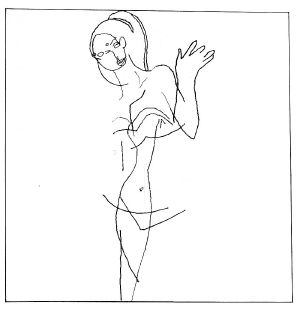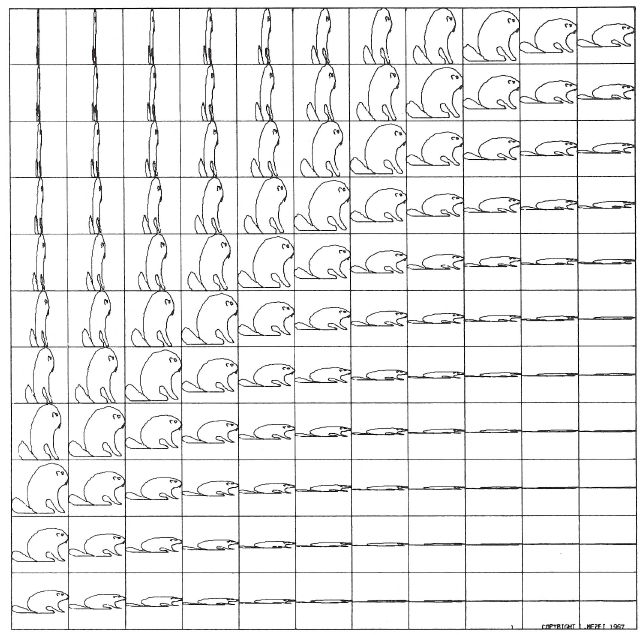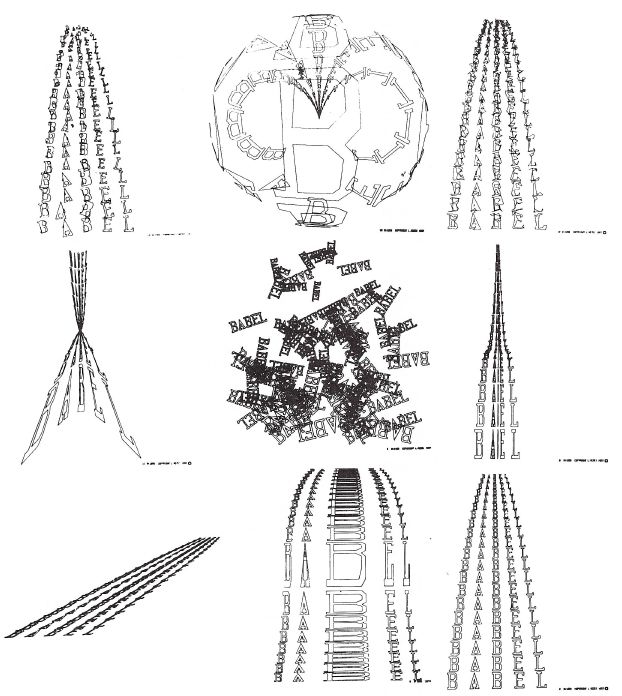 from: http://www.billbuxton.com/artistRole.html
from: http://www.billbuxton.com/artistRole.html
"For centuries, there has been a kind of love/hate relationship between the arts and science and technology. From the artist's perspective, this has sometimes take the form of confrontation. At other times, it has resulted in new materials and techniques that enabled artistic breakthroughs. (Architecture, for example, is full of such examples.)
Our own era is no different. If anything, artist/technology synergies and confrontations are more visible today than in any previous period in history. Taking this view, as the result of my experience over the past twenty years, I believe the arts/sciences relationship begs scrutiny and discussion. That is my objective in what follows. The perspective that I take will be that of the artist.
My underlying view is that in the art/technology equation, the artist is too often viewed as some kind of welfare case begging for resources and at the mercy of the benvolent technologist who controls the means to production. Admittedly, this is an over simplification. Nevertheless, I feel strongly that the artist brings far more to the relationship than is generally acknowledged.
My central thesis is, therefore, that I believe that there is a vital role for the artist in the laboratory and that this role is equally beneficial to artist and scientist, alike. To summarize before the fact, the objective of what follows is to give my arguments for why I believe "all" research labs should have an artist in residence program. (I will leave it for another time to make the converse argument, why all art colleges should have a scientist in residence program.)
My first argument for the mutual benefit of art/science collaboration is based on precedent. First, there are some good examples of artists collaborating with scientists to produce art. An example is the whole arts-science mix orchestrated by Billy Klüver and EAT for the Pepsi Pavilion at Expo '70. In the other direction, there is a long history of artists contributing to scientific research. There is the mix of art and science in the work of Da Vinci. Then there is the case of music playing a role in the experiments that resulted in Galileo's discovery of the law of falling bodies.
A more recent example can be seen in research undertaken at the National Research Council of Canada in the early 1970s. This work in human-computer interaction took the form of two case studies: one in music, and one in animation. I conjecture that as a result of this collaborative study, the researchers at NRC knew more about human-computer interaction 15 years ago than 90% of today's "specialists". And from the other perspective, some important art was produced - most notably Pierre Foldes' film Hunger.
This mutual benefit is not isolated. At Bell Labs, for example, Max Mathew's work in computer music has contributed to numerous compositions, as well as our knowledge of psychoacoustics and speech synthesis. And at the same lab, work in animation by Ken Knowlton and Lillian Schwartz resulted in several films, and also contributed towards new techniques for displaying molecules. Finally, at the University of Pennsylvania and at Simon Fraser University, work in dance notation involving computer scientists, dance notators, kinesiologists and a sculptor has resulted in new tools for the study of human motion. This work has contributed new insights into the biomechanics of human locomotion. "Bubbleman", a computer model of human that was developed has even been used by NASA in studies of cockpit design and crash simulation.
To summarize our first argument, there are several clear examples of successful collaborations between artists and scientists (of which we have mentioned only a few). The point emphasize is that the benefits have gone both ways.
This brings me to my second argument. I believe that technology is currently faced with a set of research problems to which the artist can make a particular contribution. The problem is in realizing the full potential of the evolving microelectronic and communications technologies: potential from the the educational, recreational, commercial, social, and information providing perspective. Until very recently, computer scientists have designed systems for computer scientists. However, designing for a more general public presents a whole new set of problems - problems which require a multi-disciplinary approach. We can no longer afford to partition teams by profession. The industrial engineer, electrical engineer, behavioral scientist, computer programmer, psychophysicist, and graphic designer, animator, and composer all have their respective roles to play.
Visually rendering data so that it effectively informs is something that graphic artists do well. An excellent example of this is the work of Aaron Marcus who has made an important contribution to augmenting computer scientists' knowledge about effective display lay-out and typography.
In a similar way, animators understand the use of visual images over time, and therefore have a contribution to make in the effective graphical representation of computer simulations. Finally, musicians (especially those who write for film) have a wealth of knowledge in how to use sound to highlight key features of what is being viewed, or to communicate information in the absence of visual contact. For example, the work of Sarah Bly on using sound cues in the analysis of statistical data could not have been carried out without the contribution of work in computer music.
My third argument is the easiest to state, but the most difficult to measure. I believe that there is a very important socio-political benefit that accrues from collaboration. I believe that our society is increasingly being polarized into two groups: those intimidated by technology (cyberphobics) and those who place all their faith in it (cyberphillics). To break down this polarization, technologist must acknowledge the legitimacy of the cyberphobic's fears, just as the cyberphobic must understand the positive role that technology can play in society. Technical literacy will permit the humanist to function as an informed watch-dog as well as make some contribution to the enlightened use of technology. Involvement in the arts will help the scientist remain conscious of the human impact of technological developments. Polarization between camps is just downright dangerous.
In breaking down these barriers, artists have an important role to play. Their "business" is communication, and I see no better group with which to begin our assault on this artificial and counter-productive humanist/rationalist partitioning.
My final argument is a natural outgrowth of the issues just raised. I believe that the visual and audio arts are important areas in which to apply the emerging technologies. We have already discussed art with technology from the professional's perspective. Perhaps more important, however, is the potential impact of the technology for the amateur artist.
I subscribe to the Platonic view that everyone has some innate artistic ability, and that this creative potential is worth developing. In an era of (largely technologically induced) increased leisure time, I see it as only fitting that we capture that same technology's potential to aid in addressing problems that it helped create. Technology can provide a strong catalyst for artistic development. The New York composer Laurie Spiegel speaks of the microprocessor as "the folk instrument of the 80's", and there is compelling evidence that she is right. The point is, to fully develop the potential of this "digital folk art" will require the active collaboration of both professional artists and scientists.
If there is so much to benefit from arts-science collaboration, then why is it so hard to get projects going?
In my opinion, one reason is that the existing funding agencies are not well equipped to deal with most such projects. Having separate funding bodies for the arts, humanities, and engineering sciences makes interdisciplinary projects difficult to put forward. In addition, the environment for research in most universities is one which rewards increased specialization rather than encourages interdisciplinary cooperation. Clearly we are in need of some new mechanisms and policies.
Next, there needs to be a re-education on the side of both the artist and the scientist in order that each learn to respect the other, understand that they have common problems, and recognize that each stands to benefit as a result. The artist can no more afford to be scientificly illiterate than the scientist can afford to be illiterate in the humanities and arts.
Finally, I do not believe it overly dramatic to conclude by stating that without mutual respect and collaboration between the "two cultures", what future there is will be pretty bleak. Artists are not second class citizens who have access to technologies only at the whim of some scientific "guardian of the castle." Their importance and value is real, and has been sold short for too long. It is time for a change.
Acknowledgements
I must acknowledge the contribution made to this article by Catherine Richards, Ron Baecker, K.C. Smith, and Alain Fournier. Our (often animated) conversations have not only helped shape my opinions but have also provided yet another example of the benefits of cross-discipline pollination. In addition, Lillian Schwartz, Norm Badler, Max Mathews and Ken Knowlton have all made valuable comments and suggestions."
 "Hunger" or "La Faim" is an 11 min 2d-computer animation by Peter Foldes, composed of hand drawn images and digital metamorphosis, nominated for the acadamy award in 1974 (didn't win).
"Hunger" or "La Faim" is an 11 min 2d-computer animation by Peter Foldes, composed of hand drawn images and digital metamorphosis, nominated for the acadamy award in 1974 (didn't win).







